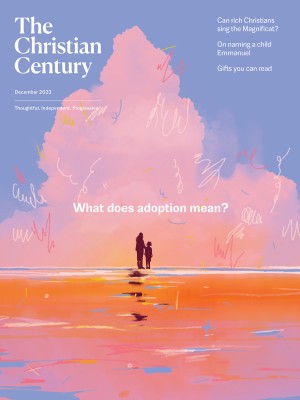December 31, Christmas 1B (Isaiah 61:10–62:3; Psalm 148; Galatians 4:4–7; Luke 2:22–40)
Simeon and Anna echo the worship material of ancient Israel.
Luke’s Christmas story not only features babies and parents, it also focuses on the elderly.
When I was a student at Trinity Lutheran Seminary, one of my fellow students asked me to help with his preaching on the encounter with Simeon and Anna in the temple. We sang “Old Friends,” by Simon and Garfunkel, and then he preached on this passage from Luke.
Old friends rejoiced at God’s saving presence along with younger ones. The first witnesses to Jesus included the elderly as well as peasant shepherds.
After the birth of Jesus, the first week for the Holy Family must have had its adjustments. But on the eighth day, Joseph and Mary bring Jesus to the temple in Jerusalem for his dedication. Their modest station in life is reflected by the offering they bring: two turtledoves or pigeons.
Read our latest issue or browse back issues.
When they arrive at the temple, Luke presents an endearing set of encounters, as the text now focuses on Simeon and his devotion: “This man was righteous and devout, looking forward to the consolation of Israel, and the Holy Spirit rested on him. It had been revealed to him by the Holy Spirit that he would not see death before he had seen the Lord’s Messiah.”
Think of it. A sense of hope and promise that he has harbored for years or even decades is now becoming a reality. One can imagine Simeon’s embrace of our passage from Isaiah, on which he has perhaps been meditating for some time. As the psalmist rejoices in the Lord, clothing him with garments of salvation, so the Lord also causes righteousness and praise to spring up among the nations—in this case, as a baby.
Luke notes that Simeon is guided by the Spirit in his encounter with Jesus and his parents. Echoing Isaiah 9:2, Simeon offers a momentous prayer: “Master, now you are dismissing your servant in peace, according to your word; for my eyes have seen your salvation, which you have prepared in the presence of all peoples, a light for revelation to the Gentiles and for glory to your people Israel.”
Simeon then turns to Mary, prophesying that her child will bring about “the rising and falling of many in Israel and to be a sign that will be opposed so that the inner thoughts of many will be revealed.” Thus will a sword pierce her soul, as well.
At this point, the widowed prophetess Anna enters the scene; she is 84. Her spontaneous praise over the Christ Child declares hope to those looking for the redemption of Israel. Anna praises the Lord along with the psalmist’s angels, sun and moon and stars, and sea creatures. This includes “young men and women alike, old and young together,” for all are praising the name of the Lord together when God’s momentous salvation appears.
Simeon and Anna echo the worship material of ancient Israel. And the hymns of Mary, Zechariah, and Simeon in Luke’s first two chapters reflect the worship material of early Christians as well.
As Paul celebrates in the reading from Galatians, “when the fullness of time had come, God sent his Son, born of a woman, born under the law, in order to redeem those who were under the law, so that we might receive adoption as children.” As a result, we too receive the gift of adoption into the divine family, whereby we now cry out, “Abba! Father!”—no longer servants or slaves, but actual family members as children and heirs of God.
Luke concludes the scene with a second travel narrative, reporting the Holy Family’s return to Nazareth of Galilee. As the child grows in strength, he is also filled with wisdom and God’s favor. May we also be open to God’s wisdom and favor, as we enter the new year and as we celebrate the coming of the Messiah-Christ in our own lives.





